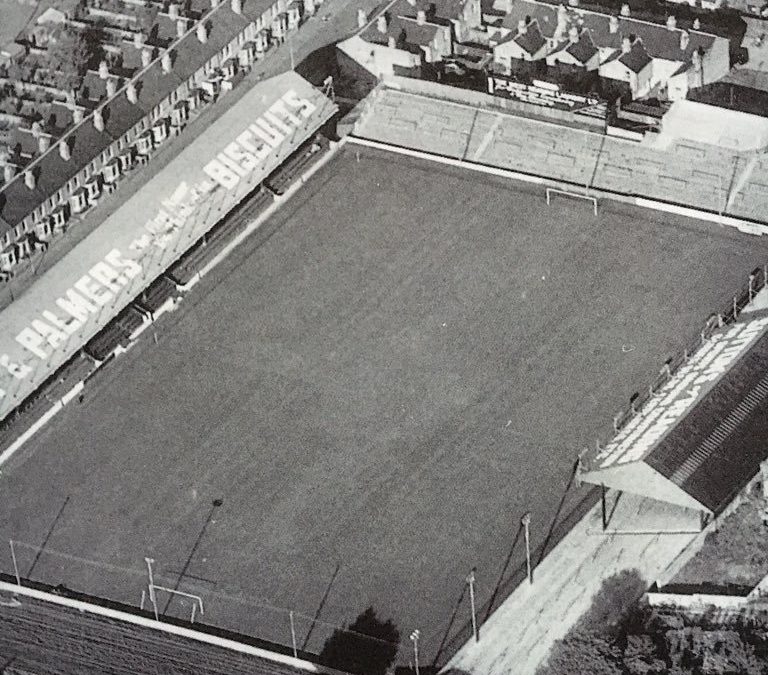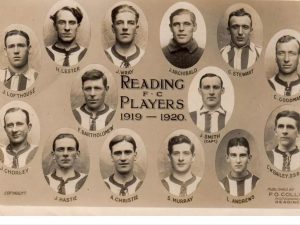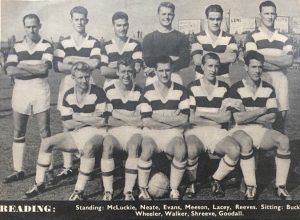BY Vince Cooper
READING FC were formed on Christmas Day 1871 at the Bridge Street Rooms with Joseph Edward Sydenham as the club’s driving force. Sydenham chaired the first meeting and then became Honorary Secretary of the new club.
There were two other clubs in the area competing for players and fans. The first of these, Reading Hornets, joined up with Reading in 1877 and the following year the club won their first trophy, the Berks and Bucks Senior Cup. In the 1881-82 F.A. Cup the club got through three rounds, seeing off Hendon, going through after West End were disqualified and receiving a bye in the 3rd round before they failed to put out a team against Marlow who got a walkover. The other local club, Earley amalgamated with Reading in 1889.
The club stayed in the amateur ranks for the first 24 years of their existence, before turning professional in 1895, shortly before moving to Elm Park.
The team had originally played on open fields at Reading Recreation Grounds where their first match was a goalless draw with Reading Grammar School. In 1877 the club switched their FA Cup 1st round tie with South Norwood to the Dolphin Stadium in Slough as it was decided that the Recreation Ground was too small. They won the match 2-0 but were knocked out by Upton Park at the next stage.
With little to no facilities at the Recreation Ground and with spectators frequently encroaching on the pitch the club decided in 1878 to switch to nearby Reading Cricket Club where the first game was a 1-0 defeat to Pilgrims. This move enabled the club to charge admission (3d – season tickets were 2s).
In 1879 during a match at Reading Cricket Club, H.F. Rogers the Reading captain suffered an epileptic fit and died which caused the club to cancel all matches until January 1880 as a mark of respect.
At the start of the 1880-81 season the ground at the cricket club was under water so the club played their first match, against Old Philberdians, at the ground of a Mr A. C. Bartholomew, a member of the team.
The fact that the cricket ground was prone to flooding eventually caused the club to look for a new home and in 1882 they announced a move to Coley Park for the start of the following season.
The first match at Reading’s latest new home took place on 7 October 1882 and The Biscuitmen suffered a 4-0 loss to Marlow.
They remained at Coley Park, formerly home to an Elizabethan mansion, for seven years but there was a lack of facilities and the local squire, W. B. Monck, citing ‘rowdyism by rougher elements’ wanted them out. So, in 1889 they were on the move again.
The next home was Caversham Cricket Club where the opening match, in October 1889 resulted in a 6-1 defeat by the Second Battalion of the Royal Scots Guards.
The first problem with moving to Caversham was that it moved the club out of Berkshire and into Oxfordshire. Secondly, like their time at Reading Cricket Ground, it was prone to flooding.
Berks & Bucks Cup winners 1891-92
In 1891 the pavilion was burned down by local youths but things slowly improved and a stand with seating for 500 was added before the 1894-95 season. At the same time the club made their first appearance in league football as inaugural members of the newly-formed Southern League. Their first season saw a respectable 5th-place (of 9) finish behind runaway winners Millwall Athletic and there was also a run to the quarter-final of the Amateur Cup where they were eliminated by South Bank and a second victory in the Berks and Bucks Cup.
During that season a match was played at the home of Reading Temperance. The ground was called Elm Park but is not the one they moved into a couple of years later.
The decision to go pro came at an AGM in the summer of 1895 as the team were competing at a disadvantage with most of the top sides in the Southern League. The decision was not unanimous and some of the members who disagreed went off to form the Reading Amateur Football Club.
The new professionals spent one more season at Caversham then the move to Elm Park came. A number of options were looked at before councillor Edwin Jesse agreed to lease land in the west of the town, which was formerly a gravel pit, to the club.
The first-ever match at Elm Park took place on 5 September 1896. It was to prove something of a disaster as the Biscuitmen were leading a ‘Royston Bourke’s XI’ 7-1when play was abandoned due to torrential rain. Worse was to follow when the FA fined the club £5 and suspended them for playing against an unregistered side. On the positive side, reports at the time indicate that a healthy crowd of around 2,500 attended paying gate receipts of £44.
The club’s nickname came due to the location of Huntley & Palmer, the famous manufacturers who hailed from Reading and built the world’s largest biscuit factory in the town
After the little hiccup of the opening match the move to Elm Park would soon prove to be a successful one and despite occasionally looking at other sites (particularly in 1908 when they considered moving to ground close to the railway station), Reading would call Elm Park home for just over 100 years.
In 1897 the club purchased the land Elm Park stood on from Mr Jesse and set about gradually improving facilities. At this time they entered a second team in the Western League but the Southern League was always the main focus and they did manage to reach the runners-up spot on a couple of occasions, to Southampton in 1902-03 and to Bristol Rovers in 1904-05.
By 1909-10 the Southern League had expanded to two divisions and the team were relegated to the lower tier. But they bounced straight back as 2nd Division Champions a year later and managed another 2nd-place in the top flight in 1914-15, this time to Watford, just before league football came to a halt due to the Great War.
Perhaps the outstanding player the club had during this period was Allen Foster. A Yorkshireman, he began his career with Rotherham Town before moving to Bristol City. He was a prolific scorer for the reserves with City (including a couple against Reading) and would join the club for £75 – paid in two instalments. At Elm Park he scored more than 70 goals including one particular giant-killing stunner and a memorable hat-trick.
The South Bank before covering was added
The stunner knocked the mighty Aston Villa, the previous season’s runners-up with nine internationals in their ranks, out of the 1912 F.A. Cup and prompted the Midlanders to offer a massive (at the time) £750 for his services. Despite a serious lack of funds the bid was turned down.
The hat-trick came during the summer of 1914. Reading travelled to Italy on an end-of-season tour. There, on 12 May 1913, they met AC Milan at the Milan Arena – a stadium opened by Napoleon in 1808 – and Foster scored three in a 5-0 win which prompted newspaper Corriere della Sera to term the visitors; “without doubt the finest foreign team seen in Italy”.
During the tour, the team also beat the Italian National XI and the club made a hefty profit of £18-2-0 from their exertions.
Foster enlisted in the 17th Middlesex regiment, the famous ‘Footballers Battalion’, at the outbreak of war and in 1916 was fatally wounded while fighting at Guillemont in the Battle of Delville Wood at The Somme He was 28 and was one of nine Reading players who lost their life during the conflict.
Allen Foster’s grave
After news of Foster’s death reached home, the Reading Observer wrote: “The news of Allen Foster’s death came like a thunderclap and the death roll of Reading Football Club players is slowly mounting up.
“It seems impossible to believe that the fair-haired centre forward with a caustic tongue but loveable disposition would entertain us no more. One’s thoughts instantly flew to the quiet little woman and tiny babe”.
After his loss Reading played the Footballers Battalion in a benefit match for Foster’s dependents and raised £100.
Fans at Elm Park in 1913
Before the start of the 1914-15 season full cover was added along the South Bank or Tilehurst Road side of the ground with accommodation for 6,000 spectators. This, allied to the other roofing already in place this would allow 10,000 to watch matches under cover.
1919-20
When football resumed after hostilities ended the Football League moved to incorporate the top flight Southern League teams into a new 3rd Division and Reading were among those who made the step up for the 1920-21 season, finishing 20th in their first season. By this time 2,500 seats had been added to the South Stand.
The 3rd Division quickly became the 3rd Division (South) after further expansion the following year and Reading would remain among the basement-dwellers until the 1925-26 season saw them pip Plymouth Argyle for the title in a remarkable turnaround. The basis for this drastic improvement was the team’s form at Elm Park where they remained unbeaten in the league throughout the season.
The title, and promotion, came down to the last day. Reading needed to beat Brentford at home and hope that Plymouth lost at Gillingham to secure their place at the higher level.
Fans making their way to Elm Park for the F.A. Cup game with Brentford in 1927
Reading did their bit, hammering the West Londoners 7-1 with Frank Richardson scoring four and Ireland International Hugh Davey netting the other three. Shortly after the final whistle a young boy carried a blackboard around the pitch showing the score ‘Gillingham 2 Plymouth Argyle 1’ and that was it; Reading were champions and promoted.
The 1926-27 players
Frank Richardson joined the club from Swindon Town just in time for the promotion push and managed 12 goals in 13 games. He would spend three more seasons at the club before returning to Swindon having netted a total of 55 times including the only goal in the F.A Cup 5th round game with Brentford in 1927 which saw Elm Park host a record crowd of 33,042.
Reading then travelled to Swansea Town and beat their hosts 3-1 in the quarter-final but were ousted at the last four stage by eventual winners Cardiff City who came out on top 3-0 at Molineux.
Hugh Davey
Hugh Davey, signed from Bournemouth in 1925, managed 26 goals in 28 games during the promotion season. He left for 1st Division Portsmouth during the 1927-28 season having scored 49 times in 66 games for the Biscuitmen.
The fine season coincided with the construction of a new Main Stand on the Norfolk Road side of the ground. This would eventually hold 4,000 seats and would also be where the club offices (originally located in the centre of town) would be situated. On the opposite side of the pitch was the already covered South Bank terrace. Behind one goal was the Tilehurst End and this would become where the more vociferous home fans would congregate with away fans gathering at the Town End.
The Second Division stint lasted a mere five years during which the best the team could manage was 14th place as they continued to struggle financially and lack the backing to hang on to their best players. There was a mini-cup run in 1929 when they got the better of Tottenham Hotspur and Swansea Town before falling to Aston Villa.
After the drop the club would remain in the Third Division (South) until the outbreak of the 2nd World War. They did record a fine 8-3 F.A. Cup win over the famous Corinthians in 1935 which brought an immortal line from opposing centre-half Bernard Joy: “We had a move direct from a kick-off which we thought might bring us a goal. We got to try it nine times!”
Joe Smith
Former Bolton Wanderers and England star Joe Smith was manager in the early part of the 1930s and during his reign the team came close to promotion on a number of occasions. Smith, who had captained Bolton to victory in the first Wembley F.A. Cup final, moved on to Blackpool in 1935 where he would be in charge for 23 years, and lead them to victory in the famous ‘Matthews’ F.A. Cup Final in 1953.
Smith was replaced by another former Bolton and England star, Billy Butler. The team continued competing near the top of their division but promotion was always just out of reach. Butler, like Smith before him, was relying mostly on cast-offs, including striker Tony MacPhee was was snapped up from Coventry City in 1938 and who hit 26 goals in the 1938-39 season.
Butler resigned in 1939 and Scot Johnny Cochrane took over in the hot-seat. Just 43 days after his appointment, the Second World War broke out, regular football was suspended and Cochrane left.
Ted Drake
Joe Edelston took charge of the club during the war years when matches were played on a more local basis. He kept the job for two years after hostilities ended, before being replaced by former Arsenal and England forward Ted Drake.
Drake left his first managerial job at Hendon to take the reins at Elm Park and he brought about a clear improvement in form.
Drake spent five years at the helm and in that time Reading twice finished as runners-up in the 3rd Division (South). Sadly for the Biscuitmen and their fans only one club was promoted at that time. In 1947-48 Swansea Town denied them 2nd Division status while in 1951-52 Plymouth Argyle gained some revenge for 25 years before.
In 1952 Drake moved on to Chelsea, who he would lead to the 1st Division title in 1954-55.
Next man in the Elm Park hot seat was former West Bromwich Albion boss Jack Smith who lasted just over three years with little success. After Smith’s departure Harry Johnston, skipper of Blackpool when they won the 1953 F.A. Cup and a former England international, took charge and would spend seven years at the club, but with little success.
Action from a 1955 Cup tie with Manchester United as Duncan Edwards competes for a high ball
The team were drawn to play Manchester United in the F.A. Cup in 1955 sparking hopes of an upset. The teams fought out a 1-1 draw at Elm Park before Matt Busby’s team strolled to a 4-1 victory in the replay.
The 1954-55 team
The only good news during Johnston’s reign was when the club finished in the top half of the 3rd Division (South) in 1957-58 meaning that they would compete in the 3rd instead of 4th Division the following season after the North and South divisions were ‘joined’. For a club with clearly moderate ambitions and limited finances even this was seen as something of a ‘win’.
Snowbound
Another former England star, Roy Bentley was next in the hot seat but he too failed to produce any improvement as the club continued competing in the league’s third tier.
Manager Roy Bentley talks to his players
In 1966-67 Bentley came close to taking them up but they finally finished in 4th place and towards the end of the 1968-69 season the former England man left with coach Ray Henderson taking over for the last two months of the campaign. Bentley would return to the club in 1977 as Secretary.
Jack Mansell
Mancunian Jack Mansell was appointed as manager in April 1969 and would spend two-and-a-half years in charge. One of his first moves was to return the home kit to the traditional blue and white hoops after the club had switched to light blue in 1965.
1968-69. The last year of light blue!
Under Mansell the team played an exciting brand of attacking football, evidenced when they topped the whole of the Football League for goals scored in 1969-70, finding the net 87 times. Unfortunately it was at the expense of the defence who conceded 77 times meaning The Biscuitmen could finish no higher than 8th.
The goals scored gave Reading a place in the pre-season’s Watney Cup and the draw for the competition saw them paired with Manchester United.
Denis Law at Elm Park
A crowd of over 18,000 packed Elm Park to see Dick Habbin and Gordon Cumming score for the home team. Unfortunately the illustrious visitors got three to go through to the next round.
An aerial view
In the 1970-71 season, the goals scored were nowhere near as good with the Biscuitmen finding the net just 48 times. Opposed to this, the defence was even worse, shipping 85 goals.
A town postcard featuring Elm Park
This led to Reading needing a result on the final day of the season at Villa Park to retain their 3rd Division status. Sadly, an own goal by Terry Bell condemned them to a 2-1 defeat, and to 4th Division football.
Part two of our story of Elm Park and Reading starts with the team among the basement dwellers and the arrival of Charlie Hurley – and the mercurial Robin Friday.
It’s coming soon!
www.chrisdlee.com is a great site to visit for a more comprehensive look at Reading’s history





















